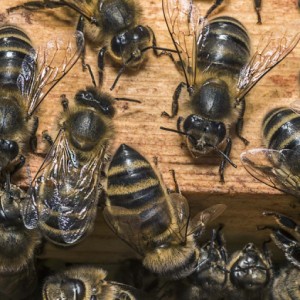I woke up feeling a little like Erwin Schrodinger, I had this box which either contained a live healthy queen bee – or it didn’t. Consequently, it was a long time before I plucked up courage to investigate and, as you can guess, there was no queen there. What I did have was a box full of grotesque bald bees; apparently it’s quite common and is probably caused by the bees being agitated and wearing their hairs away by brushing against each other. What you see, is their naked exoskeletons while the one centre stage is exposing her Nasonov gland to produce a pheromone that will summon her siblings. Despite them having been away from the parent hive for four days and coming back looking rather bedraggled, they were welcomed back into their colony, though I don’t suppose they will be of much use to it.
From looking at the queen cell, it appears that she had started to chew her way out of the end of her cell, but then the workers cut open the side of it and killed her. Thinking about it logically, there’s no evolutionary benefit in a bee colony accepting a foreign queen; its behaviour is centred around the survival of its queen’s genes, not the survival of those belonging to an unrelated queen. So, from that point of view, it’s not in the least bit surprising that basing one’s bee breeding program on using a colony of any description as a surrogate mother is fraught with problems. What is remarkable is how successful some of these techniques are; It has just been this year that there have been a lot of problems. I now have all winter to study, and perhaps have another shot next year.
The extra is of a few siblings of the bald bees for comparison.


Comments
Sign in or get an account to comment.


